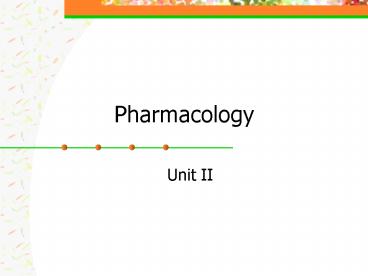Pharmacology - PowerPoint PPT Presentation
1 / 44
Title:
Pharmacology
Description:
Some organs may have opposing effects. Male sex organs may have ... Agents that influence the activity of ... From belladonna, atropine, scopolamine, ... – PowerPoint PPT presentation
Number of Views:119
Avg rating:3.0/5.0
Title: Pharmacology
1
Pharmacology
- Unit II
2
Autonomic Nervous System
- Parasympathetic nervous system
- Sympathetic nervous sytem
3
Sympathetic and Parasympathetic
- Some organs may have opposing effects
- Male sex organs may have complementary effects
- Other organs only regulated by one blood
vessels
4
3 transmitters
- Acetylcholine
- Norepinephrine
- epinephrine
5
Cholinergic receptors
- Nicotinic N
- Nicotinic M
- muscarinic
6
Adrenergic receptors
- Alpha 1
- Alpha 2
- Beta 1
- Beta 2
- Dopamine
7
Cholinergic Drugs
- Agents that influence the activity of cholinergic
receptors - Mimic or block actions of acetylcholine
8
Six categories
- Muscarinic agonists mimic
- Muscarinic antagonists block
- Ganglionic stimulating mimic effects
- Ganglionic blocking block
- Neuromuscular blocking block acetylcholine
- Cholinesterase inhibitors prevent breakdown
acetylcholine
9
Muscarinic Agonists
- Bind to muscarinic receptors activation
- Bethanechol
- Bradycardia
- Increased secretion sweating, bronchial, GI
- Smooth muscle contraction
- Pupillary constriction and accommodation for near
vision(contraction of ciliary muscle)
10
- Principle indication urinary retention
- Should be given only orally or subcutaneously
side effects increase with sc route - Contraindicated in patients with gastric ulcers
11
Pilocarpine
- Given for glaucoma
12
Poisoning
- Mushrooms and medications
- Excessive salivation, bronchospasm, bradycardia,
hypotension - Atropine muscarinic blocking agent drug of
choice to reverse signs of toxicity
13
Muscarinic Antagonists
- Atropine also called anticholinergic
- Blocks the action of acetylcholine at muscarinic
receptors
14
Atropine
- Increases heart rate
- Decreases secretion
- Relaxation of smooth muscle bronchi, urinary
bladder, GI tract - Dilation of pupil
- Relaxes ciliary muscle focus far vision
15
Atropine
- 3 hour half-life
- Orally, topically, injection
- Used to be used preoperatively to decrease
tracheal secretions
16
Adverse effects
- Dry mouth, constipation, blurred vision,
increased intraocular pressure, urinary
retention, tachycardia, asthma drying of
secretions
17
Scopolamine
- Produces sedation
- Suppresses emesis and motion sickness
18
Dicyclomine
- Bentyl, Di-Spaz
- Used for irritable bowel
19
Poisoning
- Antimuscarinic poisoning
- From belladonna, atropine, scopolamine, some
antihistamines - Dry mouth, blurred vision, hyperthermia,
hallucinations, respiratory depression
20
antidote
- Physostigmine an inhibitor of
acetylcholinesterase - Charcoal, syrup of ipecac
21
Cholinesterase inhibitors
- Reversible neostigmine
- Indication myasthenia gravis autoimmune
disorder nicotinic M receptors are reduced at
neuromuscular junction
22
- Reverse nondepolarizing neuromuscular blockade
- PACU
23
Cholinergic crisis
- Overdose with cholinesterase inhibitors
- Increased bronchial secretions
- Respiratory failure
- Atropine may be helpful
24
Irreversible
- Cholinesterase inhibitors found in insecticides
- Nerve gases
- Indication - glaucoma
25
Neuromuscular blockers
26
Adrenergic Agonists
- Sympathomimetics
- Activate adrenergic receptors catecholamines
vs. noncatecholamines
27
Catecholamines
- Norepinephrine
- Epinephrine
- Isoproterenol
- Dopamine
- Dobutamine
28
Noncatecholamines
- Ephedrine
- Phenylephrine
- Terbutaline
29
- Catacholamine receptor sites located throughout
the body
30
Alpha receptor sites
- Alpha-adrenergic receptor sites smooth muscle of
blood vessels, GI tract, GU tract when
stimulated produce vasoconstriction
31
Beta 1
- Heart muscle
- Increase contractility - inotrope
- Increase heart rate - chronotrope
- Increase av and sa node conduction - dromotrope
32
Beta 2
- Respiratory system located in bronchial smooth
muscle - Produce bronchial dilation
- Bronchodilator
- Would increase blood sugar in pts with diabetes
33
Adrenergic antagonists
- Alpha blockade for essential hypertension
- Cause vasodilation
- Pheochromocytoma, reversal of toxicity from
epinephrine, raynauds disease
34
- Prazosin selective blockade minipress
- Terazosin hytrin
- Doxazosin - cardura
35
- Phentolamine regitine nonselective
pheochromocytoma - infiltration
36
Beta blockade
- Angina
- Hypertension
- Cardiac dysrhythmias
- MI
- Heart failure
- hyperthyroidism
37
Adverse effects
- Brady
- Decreased CO
- AV block
- Rebound cardiac excitation
38
Adverse effects of beta2 blockade
- Bronchconstriction - asthma
- Inhibition of glycogenolysis
- Propranolol - Inderal
39
Metoprolol
- Cardioselective only blocks beta 1 receptors
- At usual therapeutic doses
40
Indirect-acting antiadrenergic agents
- Reduce stimulation of peripheral adrenergic
receptors
41
- Reserpine hypertension
- Clonidine centrally acting (Catapres)
42
GI tract
- Alpha1 and beta2 receptor sites
- Increasing gastric motility
- Primarily anorexiants
- Dexadrine
- Methamphetamine (Desoxyn)
43
- Also helpful for reducing intraocular pressure
and dilating pupils - Good for glaucoma
44
- END
- Return to Course Site































